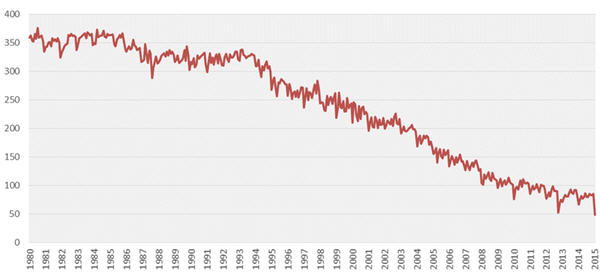SA gold miners face repeat of brutal 2014 platinum strike

Last year South Africa’s platinum mineworkers were responsible for the longest strike in that country’s history.
The strike was called by AMCU, a radical union that had been gaining strength in the platinum belt following the August 2012 killing by police of more than 30 mineworkers.
The platinum strike was ended after five months and 1.3 million ounces lost – about a third of global output.
Now AMCU is bringing its wage demands to South Africa’s gold sector, again asking for a doubling of the lowest paid workers wages and similar increases in housing benefits. That would bring entry-level remuneration for gold mine workers to $1,200 a month.
AMCU says it represents 40% of the 94,500 workers at AngloGold Ashanti, Sibanye Gold and Harmony Gold Mining. NUMSA, the union representing the bulk of workers, is asking for an 80% wage hike according to Bloomberg Business:
“Mineworkers are enslaved across the country, across the mining sector, so whatever we put forward is to liberate the mineworkers in this economic oppression,” Association of Mineworkers and Construction Union President Joseph Mathunjwa told reporters Wednesday in Johannesburg.
South Africa is the world’s sixth largest gold producer and AngloGold and Sibanye are the third and ninth largest listed gold mining companies.
While South Africa’s gold miners don’t play nearly as dominant a role in the global supply of the yellow metal as they did for most of the 20th century, a platinum-style strike would nevertheless impact the fundamentals of the industry.
Long term decline
South Africa was the world’s top gold producer for decades until 2007 when it was overtaken by China.
From a peak of more than 1,000 tonnes during the African nation’s heyday as a gold producer in the 1960s and 1970s, production has now fallen to around 160 tonnes.
Recent production numbers confirms the long term output decline for the country, but the latest drop is part of a larger trend that goes back several decades, writes an analyst for the the South African statistics agency:
Historical values of the gold index show the extent of how production has fallen. In January 1980, the index was 359,0, while the volume of gold produced was far lower in January 2015, resulting in the low index of 48,4. In other words, South Africa produced 87% less gold in January 2015 compared with the same month in 1980. Figure 1 shows how the monthly gold production index has fallen. What is not shown in the graph, however, is that production started on its downward trend well before January 1980.
The fall in production has reduced gold’s contribution to the South African economy. The metal contributed 3,8% to gross domestic product in 1993, falling to 1,7% in 20132. In terms of sales, gold made up 67,0% of all mineral sales in 1980, falling to 12,5% in 2014. Coal currently leads the pack, having contributed 27,0% of total mineral sales in 2014.
The analyst warned that depletion rates says gold resources will be exhausted in just 33 years and if the estimates hold true the country will take “on a much reduced role on the global gold mining stage.”

Monthly gold production index, 1980-2015 (Base: 2010=100). Chart from Statistics South Africa.
More News
{{ commodity.name }}
{{ post.title }}
{{ post.date }}

4 Comments
dr chivago
Lovely, the only good news I see in above is that the ANC are going to be shafted well and truly.More unemployment , more unrest and strikes , more failing companies more unrest hunger jobless peasants, I love capitalism its the survival of the fittest of the new century. And best news of all is the color is not black and white but seriously grey. Anc you have fuccked it up well and truly better resign and hand power to the opposition or face your demise and resultant payback at the polling booth.
Gary
Sign at the entrance to South Africa, in ten years time; For sale, one country, with 50 million people on it, needs major repairs due to ongoing neglect and lack of maintenance, all offers considered, must sell
miket
Why not fire the unionists and re-hire only non-union workers ? Or is that too simplistic a solution ?
berek
Yes, these chosen ones are just waiting to get rid of ANC and have complete power in SA as during apartheid. All mines MUST be nationalized!!!